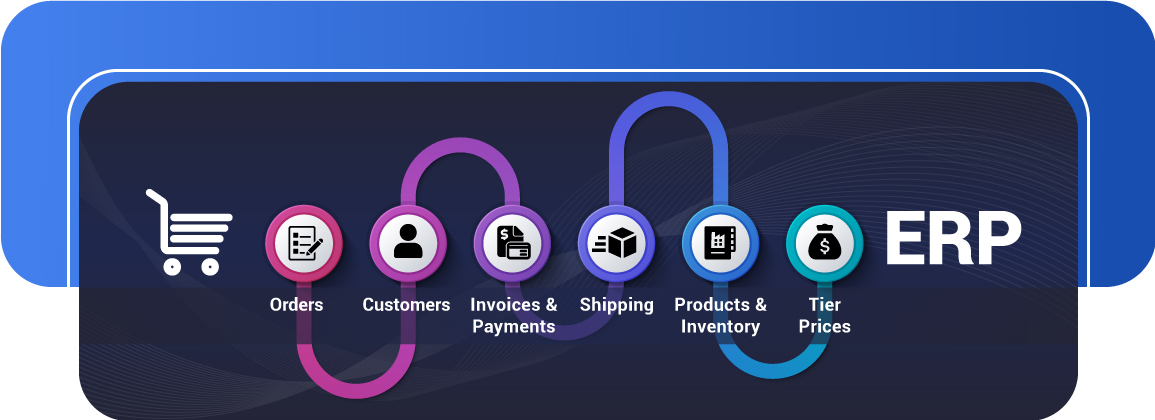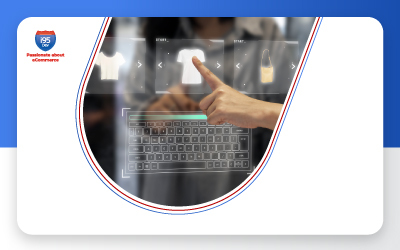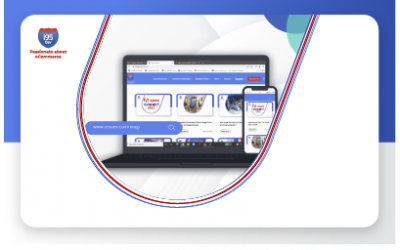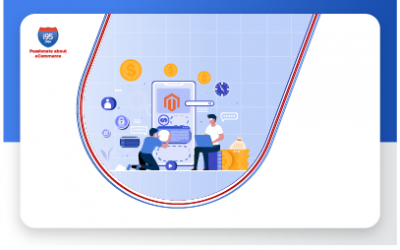6 Types of Data to Synchronize
between eCommerce and ERP Systems

This blog was first published on MSDynamicsWorld.E-commerce and ERP integration affect functions across the organization, driving benefits to each function (IT, Operations, Sales, Marketing, Customer Service, and Management) and the organization as a whole. However, identifying the data that needs to be synchronized between the two systems is the first step towards achieving those benefits.Arriving at this decision is connected to several important questions like
- What challenge are you trying to overcome?
- Are there any dependencies? For example, orders are dependent on customers, product, inventory, etc.
- What is the flow of information? E-commerce to ERP? ERP to E-commerce? or Both?
- Which one of the two systems will act as the master for the data?
- What is the current process for managing data?
- What is the frequency of data exchange? and more.
Answering these questions will streamline the data identification process. But, broadly the following data points must be considered for E-commerce and ERP integration.
Note: These are broad categories of data and there could be sub-levels to it. For example when we say product, product includes SKU, product name, description, etc.
Orders
Orders are probably the foremost reason why most businesses consider e-commerce and ERP integration. There is a lot of synergy between e-commerce and ERP systems as far as orders are concerned – while the orders are accepted in the e-commerce system and the actual fulfillment happens in the ERP system. Moreover, the ERP system also has to take care of shipping, invoice, and payments (accounts receivable, etc.), and inventory (for inventory replenishments and management).
Consider the following scenario
- You have an e-commerce and ERP system but they are not integrated.
- Because of your marketing efforts, you witness a lot of traffic on your e-commerce store and orders start to flow in.
- Because your e-commerce and ERP systems are not integrated, you manually transfer orders from your e-commerce system to your ERP system for fulfillment (probably towards the end of the day). Remember, because of manual data transfer, you can only sync a limited number of orders between the two systems.
- As the number of orders grow, to ensure quick turnaround time the only alternative you have is to add more resources to sync data between the two systems. This way, your business is always limited by the number of orders you can sync between the systems – not an ideal situation.
- Integration, can not only automate this process but will also reduce the turnaround time (because the orders are synchronized immediately) and losses that are a result of errors that are common in manual data transfers.
- Also, during the fulfillment process keeping customers updated about the order status goes a long way in improving the customer experience and integration can help you automate this by syncing the information from ERP to the e-commerce system.
Order information sync will help make your business scalable, will enable you to expand to new markets, minimize order aging, improve customer satisfaction, reduce errors and costs, streamline and automate order fulfillment process, and more.
Also consider – Order information sync is not limited to new orders. Order edits and order cancellations (refunds) also have an impact on the ERP system (fulfillment, accounts receivable, inventory, and more). But, these cannot be addressed with the basic order sync and require special attention.
Customers
The core of your business; It is absolutely crucial that this data is effectively synchronized. Synchronizing customer information between ERP and e-commerce systems is the first step that propels uniformity in customer experience.
Consider this
- A customer who often shops on your e-commerce store calls your customer service team to change its shipping address and the required change is reflected in the ERP system.
- A few days later the user logs into the e-commerce system to order something he/she would expect the shipping address change to be reflected here.
- Imagine the experience they would have if it is not; because as far as they are concerned they are interacting with your company, not your individual departments or systems.
- So, any change in customer information in either of the applications (ERP /Ecommerce) will reflect in the other post integration.
Customer information sync will help you drive benefits like building a 360-degree view of customers, facilitate multi-channel marketing, personalize customer experience, provide self-service customer portals, drive Omni-channel experience, and more.
Products & Inventory
A customer visits your e-commerce store and places an order. But, where does your e-commerce store get the product and inventory information from? Businesses often maintain all the basic product information in the ERP system (depending on the organization, the detailed product information is maintained either directly in the e-commerce system or a PIM system) and it is the central hub where the inventory information is maintained. Without this information (product and inventory) the e-commerce store cannot work effectively.
Consider the following scenario
- You are a fashion retailer where you manage product and inventory information independently in your e-commerce and ERP systems.
- A customer visits the e-commerce store, and while exploring your catalog he/she really likes a product.
- He/ she visits the product details page, finds that the product is available in the required size and is in stock, and places the order.
- A few days later, the customer receives an email that his/ her order is canceled because that product is out of stock (because inventory information was not synced with the ERP system) or is not available in that size (an error that occurred during manual data entry).
- Now, imagine the impact this could have on your customer the first time, or second time if it happens again. There is a very high probability that the customer might never come back and even recommend other customers to not buy from you.
- With integration, your e-commerce and ERP systems will always be in sync with each other and you can very easily avoid scenarios like these.
Product and Inventory sync will minimize back orders, improve customer’s shopping experience, makes it easy to sell on multiple channels, build trust and confidence with your customers, make managing product information easier, help in efficient inventory management, pave the way for omni-channel experience, and more.
Also consider – The inventory information sync can be taken to a different level when the inventory is managed and maintained in multiple warehouse locations. This would then require businesses to maintain the warehouse and inventory information in ERP system and then sync the information back to the e-commerce system. This again is an advanced functionality and requires you to go beyond the basic inventory integration.
Invoices & Payments
At the end of the day, all transactions affect payments/accounts receivable which performs the crucial function of assessing the financial status of business operations.
Consider the following scenario
- A customer visits your e-commerce store and places and order. The order and payment information is then manually transferred from the e-commerce store to the ERP system.
- The order is packed and shipped and you raise an invoice to capture the payment.
- The invoice information is manually synced back to the e-commerce system.
- While not having your e-commerce and ERP system talk to each other is not an option, manual sync is an error prone process. Imagine what would happen if the during the manual data transfer from e-commerce to ERP the payment information is wrongly entered into the ERP system.
- This will not only lead to a discrepancy in the accounting tables but also in the invoice raised and the payment captured.
- Moreover, because the payment was captured in the e-commerce system the invoice will have to be synced back to the e-commerce system to capture the payment.
- Now doing all this manually is not an efficient process and must be automated.
Invoices & Payments sync ensure consistency in the accounting books, reduces the operating cycle, automates payment capture, aids in better financial planning, aids in meeting tax compliances, improves customer experience, and more.
Also consider
- Invoice and payment sync also plays a crucial role in the event of return/cancellation of orders and refunds.
- In the case of split shipment, necessary steps must be put in place to sync the corresponding invoice for payment capture.
Shipping
Shipping is an integral part of the order fulfillment process and keeping customers informed about the order and shipment status play an important role in improving customer experience.
Consider the following scenario
- A customer visits your e-commerce store and places and order. The customer also receives an order confirmation email confirming the order placement.
- The order information is then manually transferred from the e-commerce system to the ERP system for fulfillment. Say it takes a few days for the order to be packed and shipped.
- In the meantime, the customer does not receive any updates on the order or shipment status, which is the case in this scenario, and is starting to get restless.
- The overall customer experience in this case, even if you deliver the best product in the best condition at best possible price, will not be very great.
- The integration in this scenario can effortlessly bridge the gap keeping the customer informed by automatically syncing the order status and shipping tracking number from ERP to e-commerce system.
Shipping information sync will help build trust and confidence, improve customer experience and satisfaction, streamline customer service, increase productivity and efficiency of internal resources, and more.
Also consider – In e-commerce, a number of businesses offer functionality like about multi-address checkout (allowing buyers to ship a single order to more than one address) and split shipment (fulfilling an order in smaller chunks, say when one item is not available). In such a scenario, it is important to ensure that the order status and shipping information (multiple), for each split order, is synced between the two systems. One of the biggest advantages of automating this information sync is that it further enables us to automate the fulfillment process (even auto capture payment) minimizing order aging and maximizing customer satisfaction.
Tier Prices
Not all customers are the same – differential pricing is very common and some customers always get a better deal than others. E-commerce and ERP systems handle this by defining different tiers and associating a price corresponding to that tier. Now synchronizing this information between the two systems is critical not only to ensure information consistency across systems but also to ensure consistency in the accounting books.
Consider the following scenario
- A customer visits your e-commerce store and places an order. Because the customer ordered in large quantity he/she receives a special price defined by tier price level in the e-commerce store.
- The order information is then manually transferred from the e-commerce system to the ERP system for fulfillment.
- Now, if the tier price (also known as price levels in some ERP systems) information is not available in the ERP system, the order total will be less than what the ERP system expects; because the order was placed at a price defined by the price rule applicable. This will then lead to inconsistency in the accounting books which can then further lead to compliance issues.
- Moreover, if this information is maintained in the ERP then
- if the information is not synced to the e-commerce store then you might lose the customer to competition because the customer is not offered the special price
- if the information is synced incorrectly then again this leads to inconsistencies in the accounting books
- E-commerce and ERP integration bridges this gap by synchronizing tier prices and corresponding updates between the two systems.
Tier prices information sync helps you personalize the customer experience by offering them special prices, maintains accounting consistency and reduces compliance issues.
In the next blog, we will look at the data that has to be synchronized between E-commerce and ERP system from a B2B perspective. Stay tuned!
Recent Blogs
B2B e-commerce – How Home Depot is leading the game
B2B eCommerce – How Home Depot is leading the game Author Category Share The home improvement industry has undergone a remarkable transformation, and at the heart of this change is the rise...
Accelerating Success: Best Practices for Automotive eCommerce
Accelerating Success: Best Practices for Automotive eCommerce Author Category Share In recent years, eCommerce has revolutionized the automotive sector, driving a notable surge in sales and...
Magento (Adobe Commerce) Pricing – Everything You Need To Know
Magento (Adobe Commerce) Pricing - Everything You Need To Know Author Category Share Adobe Commerce is a popular eCommerce platform used by many online stores to build and manage their...





